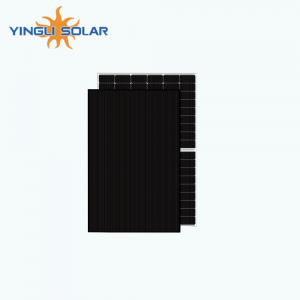Product
YINGLI PANDA 3.0 PRO 600-625W YL625C-55e 1/2
Specification
1.Panda 3.0 components and modules provide you with superior performance, stability and reliability with its industry-leading technology and high-quality manufacturing processes. No matter what environment you are in, Panda 3.0 can provide you with reliable power support to meet your various needs.
2.High-standard salt spray test verifies reliability in harsh environments
The packaging materials and structure selected by Panda modules make the modules have excellent resistance to moisture, heat and salt spray corrosion.
3.High Reliability
In addition to providing larger energy storage space, large-sized batteries also ensure stability and reliability under various environmental conditions through excellent temperature coefficients. The temperature coefficient of a battery refers to the degree of change in battery performance at different temperatures. If the battery has a high temperature coefficient, the battery's performance may be affected in high-temperature environments, and the battery's performance may be limited in low-temperature environments. However, by introducing larger cell sizes, the temperature coefficient can be lowered, thereby reducing the impact of temperature on battery performance. This enables the solar power generation system to maintain stable power output under various environmental conditions, improving the overall reliability of the system.
4.Ultra-low LID
Attenuation in the first year: 1%, annual attenuation: 0.4%.In the first year, the ultra-low LID battery has a relatively low degradation rate of only 1%. This means that within the first year, the battery has less efficiency loss and can provide end customers with long-term stable power generation income.
Parameter List
| Product number | 600 | 605 | 610 | 615 | 620 | 625 |
| quality assurance | ||||||
| product quality assurance | 12 years | |||||
| Power Output Guaranteed | Degrades 0.55% per year for 25 years | |||||
| Electrical performance parameters (STC) | ||||||
| Peak Power (Pmax) | 600 Wp | 605 Wp | 610 Wp | 615 Wp | 620 Wp | 625 Wp |
| Peak operating voltage (Vmpp) | 45.38 V | 45.48 V | 45.58 V | 45.56 V | 45.78 V | 45.88 V |
| Peak operating current (Impp) | 13.23 A | 13.31 A | 13.39 A | 13.47 A | 13.55 A | 13.63 A |
| Open circuit voltage (Voc) | 54.94 V | 55.09 V | 55.24 V | 55.39 V | 55.54 V | 55.69 V |
| Short circuit current (Isc) | 13.98 A | 14.05 A | 14.12 A | 14.19 A | 14.26 A | 14.33A |
| Component efficiency | 21.46% | 21.64% | 21.82% | 22.00% | 22.18% | 22.36% |
| Power deviation (positive) | 1.50% | 1.50% | 1.50% | 1.50% | 1.50% | 1.50% |
| Electrical performance parameters (NOCT) | ||||||
| Peak Power (Pmax) | 455.81 Wp | 459.57 Wp | 463.35 Wp | 467.14 Wp | 470.95 Wp | 474.76 Wp |
| Peak operating voltage (Vmpp) | 43.21 V | 43.31 V | 43.40 V | 43.50 V | 43.59 V | 43.69 V |
| Peak operating current (Impp) | 10.55 A | 10.61 A | 10.68 A | 10.74 A | 10.80 A | 10.87 A |
| Open circuit voltage (Voc) | 52.08 V | 52.22 V | 52.36 V | 52.51 V | 52.65 V | 52.79V |
| Short circuit current (Isc) | 11.27 A | 11.33 A | 11.38 A | 11.44 A | 11.50 A | 11.55 A |
| maximum durable temperature | 42±2 °C | |||||
| temperature characteristics | ||||||
| Operating temperature | -40~85 °C | |||||
| Temperature coefficient (Pmax) | 0.30 %/°C | |||||
| Temperature Coefficient (Voc) | 0.25 %/°C | |||||
| Temperature Coefficient (Isc) | 0.046 %/°C | |||||
| System Integration Parameters | ||||||
| system voltage | 1000 VDC / 1500 VDC | |||||
| Fuse rated current | 25 A | |||||
| physical parameters | ||||||
| Component size (height/width/thickness) | 2465x1134x35 mm | |||||
| weight | 30.6 kg | |||||
| Cell type | Monocrystalline silicon | |||||
| Cell specification | 156×156 mm | |||||
| Cell Quantity | 156 | |||||
| glass type | Tempering | |||||
| glass thickness | 3.2 mm | |||||
| border type | Anodized aluminum alloy | |||||
| Junction box protection class | IP 68 | |||||
| connector type | MC4 | |||||
| Cable cross section | 4 mm2 | |||||
| cable length | 1200 mm | |||||






